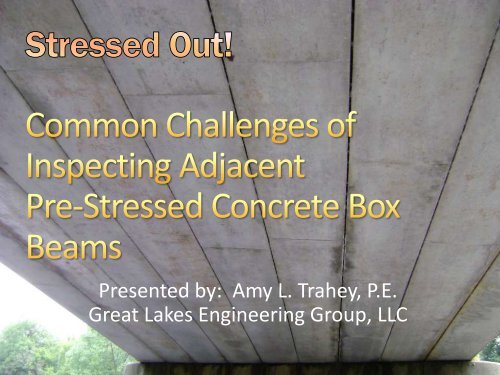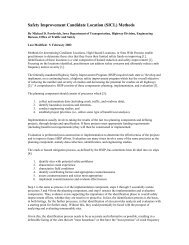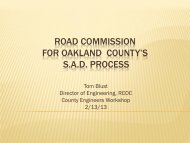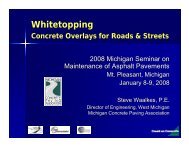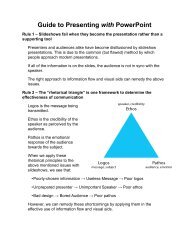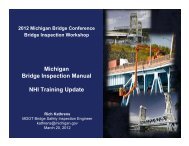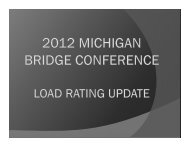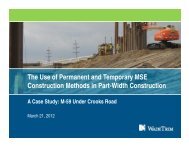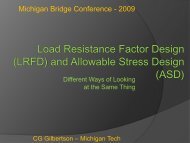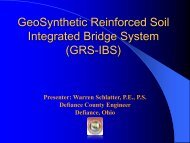Common Challenges Inspecting Adjacent Prestressed Concrete Box ...
Common Challenges Inspecting Adjacent Prestressed Concrete Box ...
Common Challenges Inspecting Adjacent Prestressed Concrete Box ...
- No tags were found...
Create successful ePaper yourself
Turn your PDF publications into a flip-book with our unique Google optimized e-Paper software.
Presented by: Amy L. Trahey, P.E.<br />
Great Lakes Engineering Group, LLC
Background and<br />
History<br />
Typical Design<br />
Characteristics<br />
Types of Distress<br />
Repair Options<br />
Future
First introduced to Michigan in 1954<br />
Economical Solution<br />
Statistics<br />
These types of structures, until recently, were<br />
proven to have been virtually maintenance free<br />
Many of the original pre-stressed concrete box<br />
beam bridges are nearing 60 years old.<br />
Realizing this type of design lacks the ability to<br />
easily retrofit, repair, and rehabilitate.
Typical span lengths range from 20 feet to 100<br />
feet<br />
Consist of either single-cell or double-cell units<br />
Partial or Full-Depth shear keys are typically<br />
filled with non-shrink grout
Typical fit up beams in 1 to 3 inches<br />
Transverse tie<br />
Post-tensioned strands common practice today<br />
Beams built in the ‘50s and ‘60s used a threaded<br />
tie rod for the transverse tie.
Primary structural components are single or<br />
multiple rows of pre-stressing strands<br />
Wearing surface is typically <strong>Concrete</strong> or HMA
Beams built before 1980 often did not have<br />
drain holes
Pre-stressed box beams built in the ‘50s and<br />
early ‘60s did not have shear stirrups that<br />
extended across the bottom flange<br />
These are susceptible to longitudinal cracks along<br />
the bottom flange
Longitudinal cracking in the deck or wearing<br />
surface
Cracking leads to leakage, which allows<br />
chloride-laden water to saturate the sides and<br />
bottoms of the beams.
Leaching between box beams
Longitudinal cracks in the bottom of box beams
Delamination, incipient spalls
Spalls to exposed steel and exposed strands
Broken pre-stressing strands
Broken pre-stressing strands
Differential movement between adjacent box<br />
beams<br />
Results in a loss of functionality of the load transfer<br />
mechanism
Shear or flexure cracks
Horizontal cracks along the fascia beams
Deterioration of the top flange of the box beam
Seal the longitudinal cracks in the surface<br />
Scarify the existing asphalt surface and install<br />
a waterproofing membrane and a new<br />
asphalt overlay<br />
Replace the asphalt wearing surface with a<br />
concrete deck<br />
Splice broken pre-stressing strands<br />
Replace individual beams<br />
Repair grouted keyway and post tensioning
Typical course of “repair” utilized today ……<br />
let it rot, load rate it, post it, shut lanes down, inspect it<br />
more frequently, and ultimately close it. This is the<br />
potential fate for adjacent concrete box beam bridges. Be<br />
prepared.
Due to the limited visual inspection techniques, this<br />
type of structure can be a “Can of Worms”<br />
Major concern is assessing<br />
corrosion of the pre-stressing<br />
strands – that you can’t see<br />
Concern that corrosion is<br />
affecting load carrying<br />
capacity<br />
It is difficult for inspectors to<br />
identify independent beam<br />
action
A call for specific rating guides for adjacent prestressed<br />
concrete box beams to be developed to<br />
help bridge inspectors<br />
NDT –<br />
Thermal Infrared<br />
Radar including Synthetic Aperture Radar (SAR)<br />
Ground Penetrating Radar (GPR)<br />
Infrared Thermography<br />
More Research
<strong>Inspecting</strong> adjacent concrete box beams can<br />
be challenging<br />
Difficult to define when corrosion will affect<br />
the load-carrying capacity the bridge<br />
Difficult to determine independent beam<br />
action or if shear keys and transverse ties<br />
are still effective in sharing the load transfer<br />
from beam to beam
The quality and efficiency of each bridge<br />
inspection is influenced by the inspector’s<br />
knowledge of how the bridge works and what<br />
controls its strength and stability<br />
An understanding of when to conduct a load<br />
rating is critical to ensure the safety of the<br />
public


